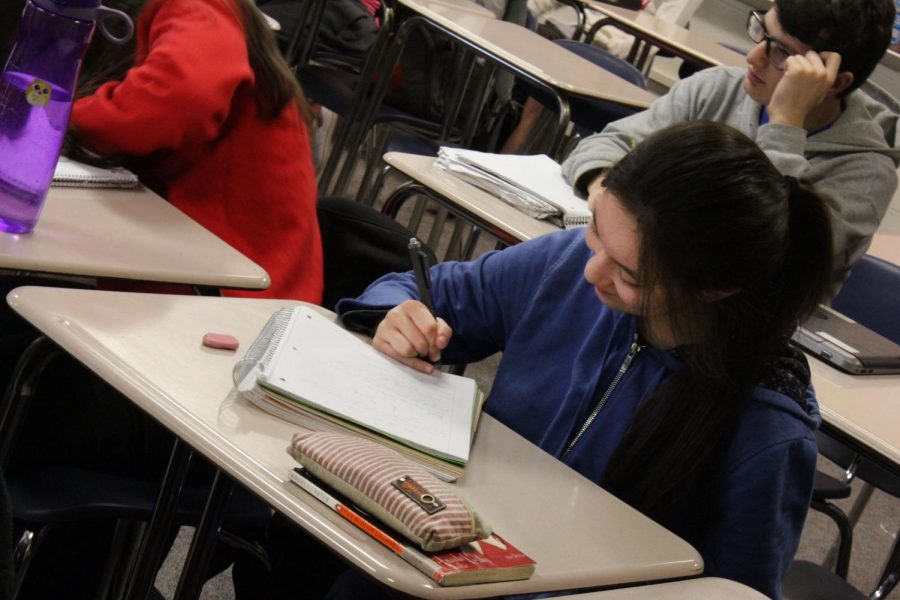Imagine the typical academic superstar South student, and a few characteristics come to mind: president of several clubs, grade point average approaching five, taking AP Physics, AP Statistics, and AP Chemistry at the same time. But wait: why is this archetypal student focused only on math and science? Why can’t someone interested in other fields, like English or social studies, reach just as much success at South? This could be because there is a disproportionate number of higher-level math and science classes, relative to arts and humanities classes.
A quick look at the College Board’s list of AP courses shows that there is a greater number of courses in the arts and humanities (English Language and Composition, World History, Macroeconomics, etc.) than in STEM‒science, technology, engineering and math‒courses (Calculus, Physics, Environmental Science, etc.).
However, this ratio is not equivalent at South, where the number of AP STEM courses is almost double the number of arts and humanities courses (nine to five). In fact, an analysis of South’s AP curriculum shows that, while the school offers 90 percent of the official AP courses in STEM fields, it only offers 38 percent of the possible AP arts and humanities courses.

This inequality means that students who are interested in math and science fields have several advantages over arts and humanities-oriented students. For one, it is easier to achieve a higher GPA, as a high-achieving student interested in STEM can take every AP science and/or math class and earn a five-point boost for each A.
A student interested in the arts and humanities may simply not want to take this many STEM classes, which is fair, as a STEM student would not want to take that many arts and humanities classes. However, the difference for the non-STEM student would be having 80 percent fewer classes to choose from and take, thus not having the same opportunity for a high GPA. This is evident in historically high-achieving South students, such as the valedictorians in years past.
Of course, being valedictorian and having a high GPA‒while helpful for college admission and scholarships‒is arguably not as important as having knowledge, and this is another disadvantage for arts and humanities-oriented students. There simply aren’t as many higher-level courses at South that are in the arts and humanities.
It can be argued that there are actually quite a few arts and humanities classes at South, and this is true: we have creative writing, journalism, sociology, and others for students to choose from. However, these are not of the same rigor as AP classes, the curriculum of which is regulated by the College Board to ensure higher-level learning. AP classes are designed to replace introductory college classes, as a high AP exam score actually counts for college credit. As enriching as elective, un-weighted arts and humanities courses are, they simply will not prepare high-achieving students for college as well as AP courses would.
Pat Cannon, the head of South’s counseling office, described the reasoning behind the inequality as “two-fold;” according to him, there are “not enough AP certified teachers” nor enough student demand for AP arts and humanities classes. However, Cannon admitted that the lack of student requests could be due to the fact that the option of taking other AP arts and humanities classes is simply not presented to students, asking, “Is that because we don’t have the ability to offer the classes?”
Additionally, Cannon said the school is more focused on preparing students to land “today’s hot jobs” in STEM fields, such as engineering or pharmacology. However, it is untrue that studying arts and humanities is impractical (see this article). When it comes to the job market, there are plenty of jobs in liberal arts-oriented fields: law, journalism, and education, for example. Thus, South students should be given an equal opportunity to pursue history as they would to pursue the natural sciences.
To clarify, there is nothing wrong with being a student pursuing fields within either STEM or the arts and humanities. Both disciplines are important and greatly contribute to our society. However, South’s lack of non-STEM AP classes emphasizes an issue within the school: the favoritism of math and science disciplines. And this does not give students who aren’t solely focused on these disciplines an equal opportunity for educational advancement.
This clear bias at the high-school level is directly disadvantaging those who favor the arts and humanities over STEM. So, what can South do to give arts and humanities-oriented students the same, specialized education as STEM-oriented students? While it is unlikely that the administration would hire four new teachers in one year, it would be a good idea to strongly move towards increasing the number of AP arts and humanities classes in the upcoming years. While it is too late for this year’s seniors to have equal educational opportunities, it doesn’t have to be too late for incoming students.

